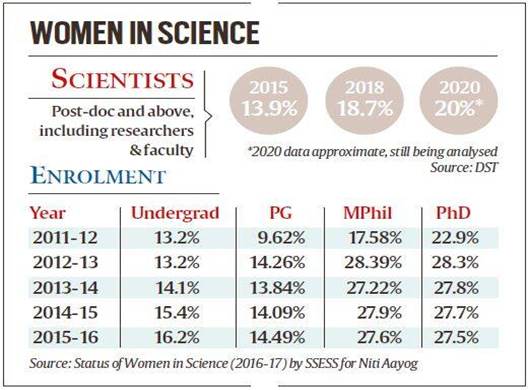Description

Copyright infringement not intended
In News
- Dr N Kalaiselvi, the first woman director general of the Council of Scientific and Industrial Research (CSIR) has stated that according to the official data “over the past two decades, Women’s participation in scientific research has been increasing”.
- In 2018-19, nearly 28% of participants in extramural Research and Development projects were women, while in 2000-01 it was around only 13%.
- The number of women principal investigators in Research and Development had risen from 232 in 2000-01 to 941 in 2016-17.
- She mentioned that “The increase in women’s participation, especially in research, is due to a combination of government programmes and natural progression”.
The reason behind Gender gaps in STEM
- Women make up only 28% of the workforce in science, technology, engineering and math (STEM), and men broadly outnumber women in most of the STEM fields in college.
- STEM fields are usually viewed as masculine, and teachers and parents constantly underestimate girls’ abilities.
- Limited examples of female scientists and engineers girls to inspire their interest in these fields.
Steps taken by the Government
- Women scientist-specific schemes provide opportunities to women scientists and technologists especially those who had a break in careers.
- Women Scientists Scheme-A (WOS-A) for conducting research in Basic and Applied Sciences.
- Women Scientists Scheme-B (WOS-B) for research that entails Science and Technology interventions for societal benefit.
- Women Scientists Scheme-C (WOS-C) for internship in Intellectual Property Rights (IPRs).
- Consolidation of University Research through Innovation and Excellence in Women Universities (CURIE)’ Programme provides support for the development of research infrastructure in women's universities.
- ‘Vigyan Jyoti’ programme to encourage meritorious girl students of Class 9-12 to pursue education and a career in science and technology.
- Gender Advancement for Transforming Institutions (GATI) aims to gender-sensitive approaches and inclusiveness in institutions.
- Biotechnology Career Advancement and Re-orientation Programme (BioCARe)’ to enhance the participation of Women Scientists in Biotechnology research.
- Indo-US Fellowship for Women in STEMM (Science, Technology, Engineering, Mathematics & Medicine) encourages women scientists and technologists to undertake international collaborative research in premier institutions in the USA for 3-6 months.
- “SERB-POWER (Promoting Opportunities for Women in Exploratory Research)” has been launched to mitigate gender disparity in science and engineering research funding in Indian academic institutions and research and development (R&D) laboratories.
- Women in Science and Engineering-KIRAN (WISE-KIRAN) programme to ensure participation of women in the field of Science and Technology (S&T).
- Nearly 40 Women Technology Parks (WTPs) have been supported under Science & Technology Scheme for Women.
- The recently released draft of the National Science, Technology and Innovation Policy, 2022 (STIP 2022) has targeted to ensure 30% participation of women in science by 2030.

Way forward
- Need to create a facilitative gender-neutral culture of research in institutions and industries.
- More women in STEM would improve the quality and create a meaningful impact on society and national needs.
- More women in these filed would support the development of products, processes, and technology that would support the goal of Women's empowerment.
https://indianexpress.com/article/india/number-of-women-scientists-up-csir-head-aims-at-further-push-8103848/
https://t.me/+hJqMV1O0se03Njk9














